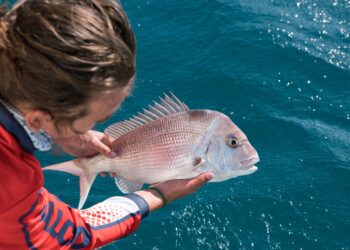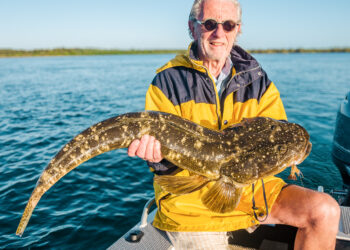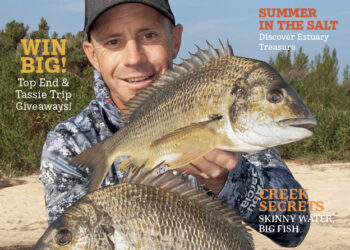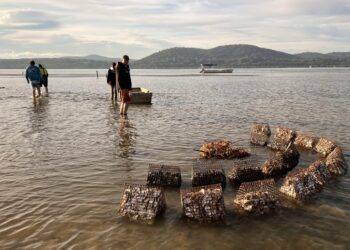In the wake of our recent stories on the massacre of permit by commercial beach haulers on the SE Queensland coast, Fisho has received reports of large scale netting of breeding mulloway along beaches on the NSW mid North Coast, the latest incident occurring as recently as last week.
The source of these claims, who wishes to remain anonymous due to fear of reprisal, has passed onto Fisho details of large hauls of netted mulloway dating back to early this year. We were also sent a market report that verified the latest sale to the Sydney Fish Markets of more than three tonnes of 25-30kg mulloway netted from the Seal Rocks area about a week ago. These fish, most of which were most likely breeding females, sold for an average of just over $7 per kilo, which according to our information is quite high. Most fish taken this way often only fetch about $3 per kilo due to the net damage they receive during hauling.
Our source says “NSW Fisheries continues to turn a blind eye to this abuse of beach hauling technique”.
This method of commercial harvesting appears to be “mostly” legal. There appear to be no clear cut regulations on target species or gear used in NSW’s Ocean Haul fishery. The NSW Industry & Investment website states: “The NSW ocean hauling commercial fishery is a carefully managed sustainable fishery that targets around 20 fish species using commercial hauling nets and purse seine nets from sea beaches and ocean waters along the NSW coastline.”
Fisho’s source told us that licensed commercial beach netters use registered “general purpose” haul nets designed for catching smaller species such as mullet. The nets are also used to haul mulloway, as well as large numbers of bream and luderick, from the surf. Australian salmon too have also been the target of beach haul netters in the past, with an incident late last year at Crowdy Bay making television news when thousands of dead salmon washed up for several kilometres along the local coastline.
The source Fisho spoke with says beach haul netting has become more sophisticated in recent times – a far cry from the past when mullet were targeted with nets set from row boats. Powerful motorised boats, stronger nets and tractors are now commonly used to haul out the catch, often wiping out a whole school in the process.
While Fisho doesn’t begrudge anyone the right to make a living, we question the ethics involved with commercial operators targeting schools of large breeding fish.
It needs to be stated that not all commercial fishers in the NSW mid North Coast region targeting fish such as mulloway use these sort of unsustainable methods. Some professionals in the region prefer to apply “self regulating” handline methods in a bid to limit their catch and ensure future fish stocks.
The problem, however, seems to be a lack of management and leadership from government. A spokesman from NSW Industry & Investment, the department in charge of fisheries, told Fisho that “a relatively short list of target species is identified for each method in the Ocean Hauling Fishery’s Share Management Plan.
“Traditionally a much broader range of species have been taken and while not generally targeted all year, these additional species may be targeted by fishers on occasions. ‘Conditional Target Species’ are those species which are targeted occasionally by ocean hauling fishers and which form a small but important part of the fishery.”
We deciphered that to mean that if beach haulers spot a school of mulloway, they can put their nets around it and take the lot, regardless of the fact that the fish may be part of a spawning aggregation.
We also asked if NSW I&I was aware that large numbers of breeding size mulloway were being netted on the NSW mid North Coast and if there were concerns about the future impact on stocks due to this seemingly unregulated netting activity
“Catches vary substantially from year to year, however (jewfish) do not generally constitute a major part of the fishery,” the I&I spokesman said. “A review of arrangements in the Management Plan is undertaken if the contribution of conditional target species and by-product species to the total annual landings (for any method) exceeds 5% in two consecutive years.”
We deciphered that to mean that I&I don’t consider the removal of three tonnes of breeding mulloway from one beach to be a major problem.
Interestingly, the NSW I&I spokesman indicated that recreational anglers, not commercial operators, are the main cause of declining mulloway stocks.
“Catches by ocean hauling fishers constitute only a small portion of the overall mulloway catch and available information (via a national fishing survey) indicates that recreational fishers are the major harvesters of the species.”
Yeah, right!
When was the last time a beach fisho caught three tonnes of jewies? Let’s look at that more closely. Say the average jewie caught off a beach is 20 kilos. Dividing 3000kgs by 20 is 150 fish. A switched-on beach angler might catch one 20kg jewie per week (if he was bloody lucky!). That would mean to catch the three tonnes of fish caught in one fell swoop by the netters, an angler would need to spend around three years on the beach!
Or, to extrapolate further, you would need 150 anglers fishing the same stretch of beach for a week each to catch the three tonnes of fish the haulers took in less than an hour or two.
Based on the above summations, we politely suggest to I&I that they are full of crap.
Fisho has heard unsubstantiated reports that the NSW Ocean Haul Fishery is to undergo a complete review in the near future. Let’s hope it does and that jewfish, along with bream, whiting, salmon and blackfish, are removed from the netters’ licences.




















